Famous Color Diamonds

A diamond’s fame can be owed to its size, its beauty and at times its historical provenance — sometimes factual, sometimes legendary. Like many historic colored diamonds and colored diamonds jewelry, much of a diamond’s fame is earned by virtue of the fame of its owner. The following include a few examples of diamonds which come with a legacy.
The Sancy Diamond
The Sancy Diamond, is a 55-carat, light-yellow diamond, which is the most famous natural color fancy yellow diamond in existence. Originating in India and named for its first verified owner, French Ambassador to the Turkish court Nicholas Harlai of Sancy, it was purchased in Constantinople in the late 1500’s. Beginning with that date, it was loaned to French royalty, including Kings Henri III and IV, the former placed it in his cap to cover his baldness and the latter used it as security to finance his army. It then changed hands to English royalty. It later returned to France, purchased by Cardinal Mazarin for Louis XIV, was stolen during the French Revolution, and then was bought and sold, and vanished again until it re-surfaced in and crossed the ocean to America, having been purchased by William Waldorf Astor. In 1978 it was sold by the Astor family to the Louvre for $1 million, where today it is on exhibit.
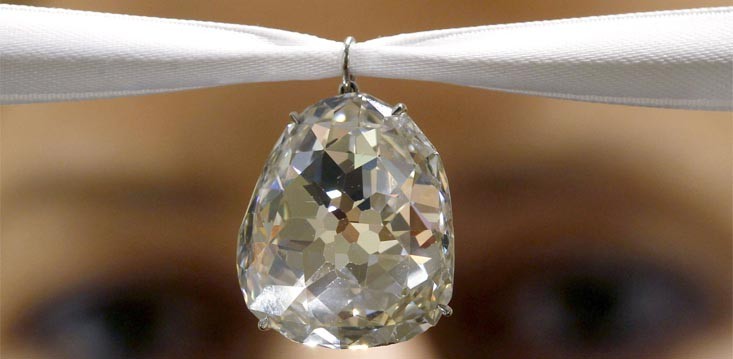
Tiffany yellow diamond
The 287-carat Tiffany Diamond is also a member of the family of natural color yellow diamonds. Its appearance of smoldering fire is the result of its unique cut and it is one of the largest diamonds in this color group. Found in South Africa’s Kimberley Mine in 1877, it was purchased by Charles Tiffany for $18,000, thus earning its name. Much of its fame is due to the publicity it acquired after its use in the film, Breakfast at Tiffany’s, starring Audrey Hepburn. Today it can be viewed at Tiffany’s New York flagship store.
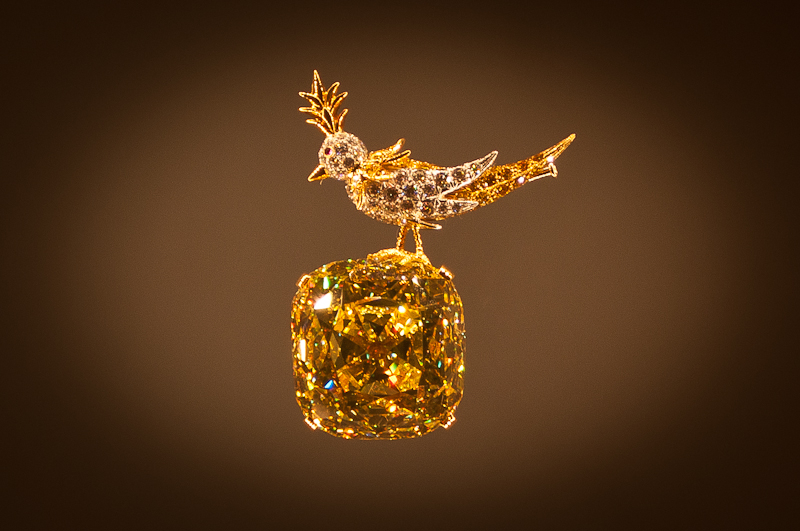
Moussaief red diamond
Color and size are part of the fame of the Moussaieff Red, which at 5.11 carats is the largest known natural color red diamond. It was purported to have been discovered in the 1990’s by a Brazilian farmer in its rough form weighing 13.90 carats. The William Goldberg Diamond Corporation purchased and cut the stone into its triangular shape (sometimes referred to as a trillion or trilliant), and the GIA grade determined that it was the largest red diamond ever graded. Eventually it was purchased by the Moussaieff Jewellers Ltd. around 2001for an undisclosed amount. Although its price was undoubtedly high, this red diamond is internally flawless, which has probably made its value only increase.

The Koh-i Noor diamond
The Koh-i Noor Diamond (translated to “Mountain of Light” in Persian) once possessed the title of the largest known diamond in the world, and its current weight is 108.93 carats. Its history, the longest of any known diamond, has its origin in India. Its past is fraught with combat to possess it among its previous Mughal and Indian royal owners. Seized by the East India Company as partial indemnity after conflict with the Sikhs, the Koh-i Noor was presented to Queen Victoria on being proclaimed Empress of India in 1877, and ever since it has been part of the British Crown Jewels kept in the Tower of London. This diamond’s associated legend gives its possessor dominion over the world.
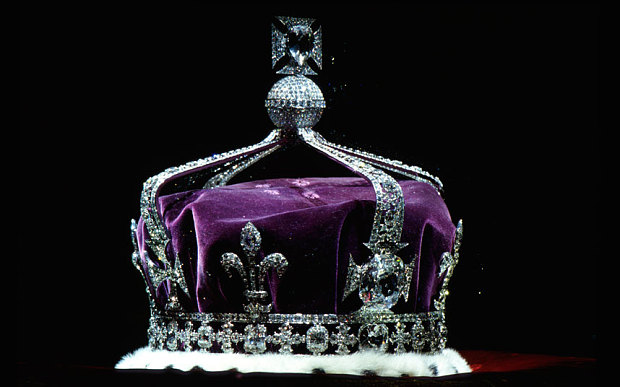
The Darya-i Noor pink diamond
This pink diamond, revealing a very rare pink color shade, not often found in nature, weighs an estimated 182 carats, making it among the largest pink diamonds in the world.
It measures 41.40 mm x 29.50 mm x 12.15 mm, and its shape is wide and oblong. Darya-I Noor, meaning “Sea of Light” has a history nearly 400 years old. It was found in India’s Golconda Mines. Nader Shah, a Persian ruler who invaded that part of India in 1739, seized the Mughal treasury, including the pink Darya-i-Noor diamond, in exchange for returning the Mughal crown and brought his treasure back to Persia, where the Darya-i Noor proceeded to be transmitted down through various dynasties.
It eventually was kept in the museum of the treasury, and was only sometimes taken out to be worn on occasions. According to researchers, the Darya-i-Noor pink diamond was part of what Tavernier called the “Diamanta Grande Table”, said to be over 400 carats, decorating the throne of the Mughal emperor, Shah Jahan, cut into two,
one part of which became the Darya-i Noor Pink. Today this pink diamond is permanently displayed in Tehran as part of Iran’s Crown Jewels.
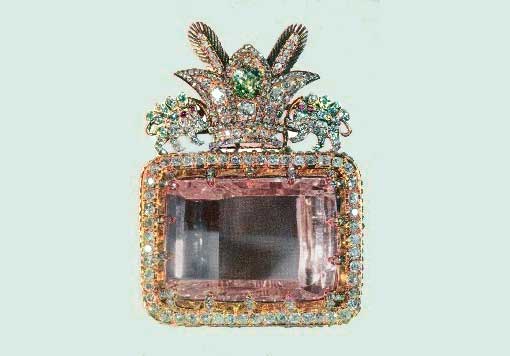
The Wittelsbach-Graff blue diamond
This blue diamond was mined in Golconda, India, and the original stone weighed 35.56 carats and measured 24.40 mm in diameter by 8.29 mm in depth. It featured a unique arrangement of 82 facets. In 1722 it was brought by Maria Amalia of the Habsburgs to Munich upon her marriage to Charles of Bavaria, a Wittelsbach, which accounts for the first half of the diamond’s name. In 1745 it was mounted on the Order of the Golden Fleece, and later in 1806, the first king of Bavaria, Maximilian IV Joseph von Wittelsbach, featured the diamond in his royal crown. The blue diamond remained part of the Bavarian royal crown until 1921.
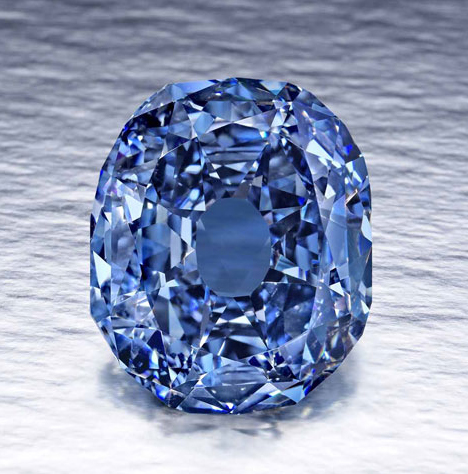
The Dresden green diamond
The Dresden Green diamond is the largest and the most famous green diamond in the whole world.
It was mined in the Kollure mine, Andhra Pradesh, India. This pear cut historical green diamond weighs 41 carats. It is of a unique apple green color. It is named after “Dresden”, the capital of Saxony, Germany as it has been displayed there for about two centuries.
It is all the more famous due to the history behind it; a London news sheet mentioned it for the first time in an article in 1722.
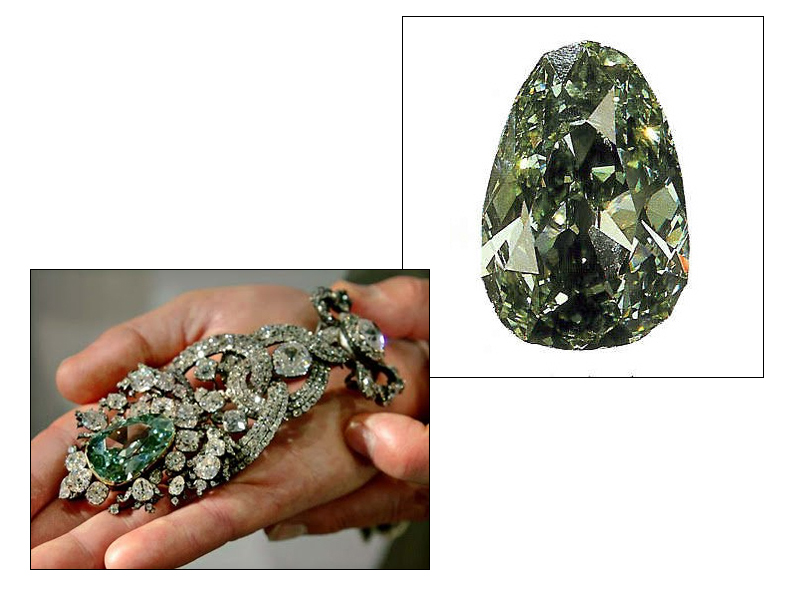
Pink star diamond
The nearly 60-carat diamond was supposedly purchased by Isaac Wolf in a New York Sotheby's auction. The bidding began at forty eight million Swiss francs and from that point moved upward. A fervid five minutes ended in the auction hammer being slammed on the podium and
a world record of $83 million was set! Applause greeted the acceptance of the final bid, along with the “Pink Panther” music playing (no invitations to thieves, hopefully) and some pink bubbly. This beat out Sotheby’s previous record sale of what is known as the Graff Pink. The next largest diamond graded by the GIA in the Pink Star’s class (or as it is now known, The Pink Dream) was not even half the size of the diamond currently sold.
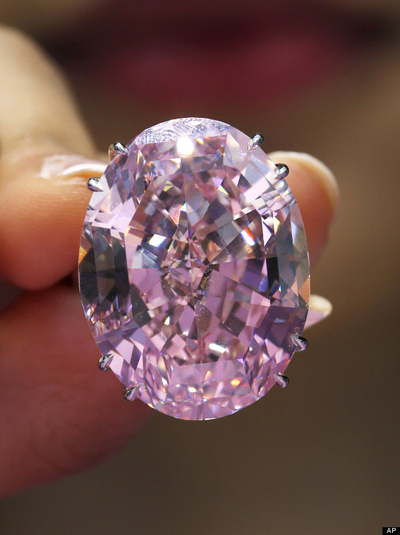
The Orange diamond
The Orange, weighing 14.82 carats was sold in Geneva at Christie’s and set a record for its nearly $2.4 million price per carat as well as setting a record for orange color diamonds. Its sale price was a bit over thirty five and a half million dollars. The purchaser, who was in the room, left immediately and is for now an anonymous one. The pre-sale estimate had placed the diamond somewhere between seventeen and twenty million dollars, and the bidding began with ten million Swiss francs
for this rare diamond, which almost quadruples the size of orange-range colored diamonds. Pure orange diamonds, which have also been given the name “fire” diamonds, are very rare in nature. The orange color is the result of nitrogen’s presence during the diamond’s formation. The GIA did the grading for “The Orange,” and emphasized the rarity of the strong vivid orange hue of a diamond this size.
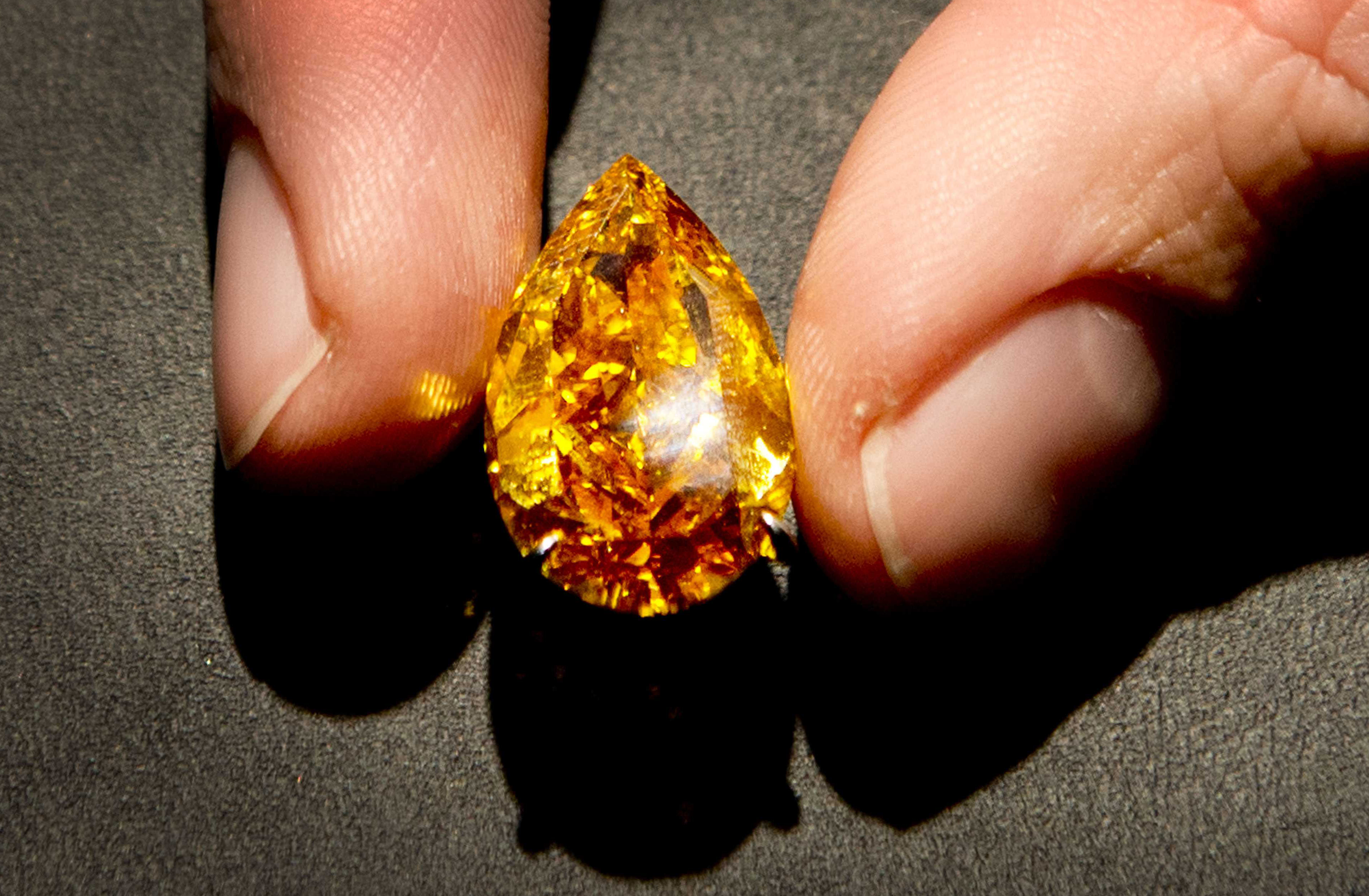
Golden Jubilee diamond
Weighing 545.67 carats, this yellow-brown fancy color diamond is the largest faceted diamond in the world. Found in South Africa’s Premier Mine in 1985, it weighed 755 carats in the rough. Prior to its discovery, the Cullinan I was the largest faceted diamond. When the Golden Jubilee was discovered, it was considered an unattractive diamond, and worthless. The diamond was given to Gabi Tolkowsky, designer of many of the largest fancy color diamonds in the world, by De Beers in order to test special tools and cutting methods, without expecting spectacular results. After two years of intensive work, the diamond rose-cushion cut revealed the diamond’s splendor and its fiery blaze of color. It went from being known as “the unnamed brown”, to acquiring its current title, as the Golden Jubilee, after it was presented to the King of Thailand in 1997 marking the 50th anniversary of his coronation. Today it is exhibited in Thailand.
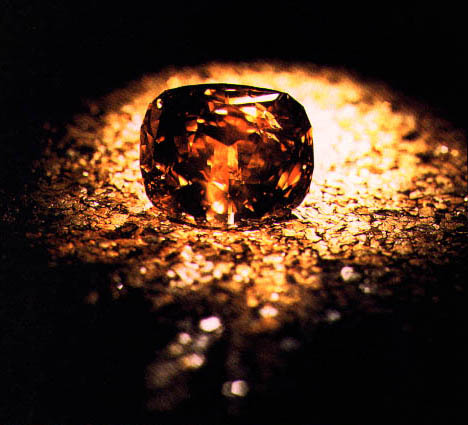
Blue hope diamond
When exposed to ultraviolet light, this 45.52 carat deep-blue, cushion-cut diamond exhibits a unique red phosphorescence after exposure to short-wave ultraviolet light. It has been classified type B the Gemological Institute of America’s Gem Trade Lab (GIA-GTL) as a Type IIB diamond, and they have characterized its color as “fancy deep grayish-blue”. Its “glow-in-the-dark” effect may have fueled some of the stories of the diamond being cursed, whereas in truth it merely indicates the mix of boron and nitrogen in the stone. Its history begins in India, where the original stone was discovered. It is believed that in its rough form it weighed 112 carats. There is a legend that the rough stone was one eye of a statue of Sita, the Hindu goddess wife of Rama, which was then stolen. The legend continues with a curse put upon the gem, involving bad luck and death for the diamond’s owner and for anyone who touches it.
The Blue Hope Diamond became known to westerners when Jean Baptiste Tavernier, a 17th century French traveler, brought the large, rough, steel-blue stone to Europe, whether by theft or purchase, and the stone, cut, and re-cut stayed in the possession of French royalty until the end of the 18th century.
The blue diamond then made an appearance in England, with 1830 being the most reliable date for its initial appearance. It was owned by an English banker, Henry Thomas Hope, and it figured in an exhibition in London in 1851. The blue diamond received the family name of its owner, and was passed down within the family.
The Hope Diamond traveled to the United States, but then resurfaced as part of the Turkish Sultan Abdul Hamid II’s treasury. In 1911 it was purchased from Pierre Cartier by Mrs. Evalyn Walsh McLean, and the blue diamond remained with her until her death in 1947, after which the entire McLean collection, including the 95-carat Star of the East and other unique diamonds, was bought by the well-known jeweler, Harry Winston. Winston later donated the Hope Diamond to the Smithsonian Institution in Washington, D.C.
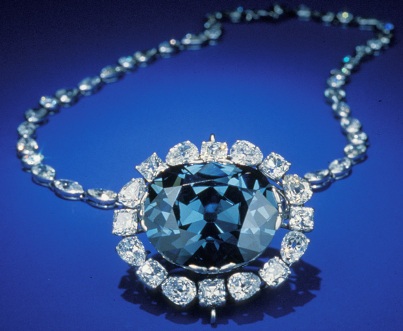

- Contact
- Contact Us
- B2B
- Our Diamonds |
- Jewelry |
- Blue Diamonds |
- Orange Diamonds |
- Pink Diamonds |
- Yellow Diamonds |
- Purple Diamonds |
- Green Diamonds |
- Chameleon Diamonds |
- Gray Diamonds |
- Black Diamonds |
- White Diamonds |
- Violet Diamonds |
- Red Diamonds |
- Champagne Diamonds |
- Diamond Pairs |
- Diamond Layouts |
- Diamond Rings |
- Diamond Earrings |
- Diamond Bracelets |
- Diamond Necklace |
- Diamond Pendants |
- Colorless Diamonds |
- Natural Gemstones |
- Argyle Pink Diamonds |
- Zimmi Yellow Diamonds













 Powered by
Powered by